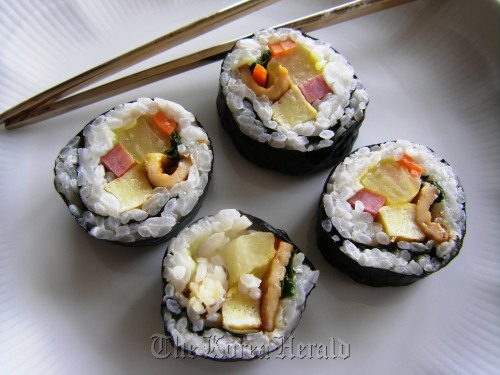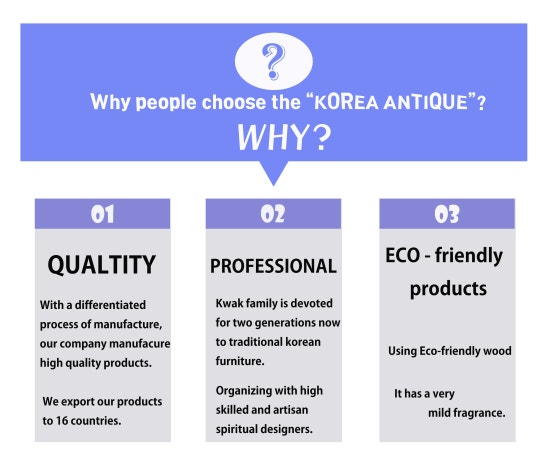

Kimbap, the quintessential Korean snack
Kimbap, the quintessential Korean snack

When I decided to do a column featuring ubiquitous Korean snack food kimbap, I knew it would be an emotional piece. My earliest experiences with kimbap are irrevocably intertwined with memories of my dear nanny and housekeeper, who was like a mother to me and a beloved grandmother to my daughters. Ms. Paek, as we always called her, even after she transitioned from housekeeper to full member of our family, passed away about five years ago. She was a wonderful, kind woman, and I miss her dearly to this day.
Ms. Paek would always make us kimbap, and she would serve it so elegantly, as if it wasn’t a common snack food at all, but a delicious gourmet delicacy. My youngest daughter, the baby of the family, loved eating the dried seaweed, or kim, by itself or with rice, so Ms. Paek would accommodate her with trays of kim and rice when she got home from school. For a long time, I didn’t understand the appeal of the crunchy-salty sheets of kim. Ms. Paek tried so hard to help me see the error of my ways. She would smile and say, “Mommy, eat, it is good for you, lots of minerals and vitamins.” Eventually, I had to give in -- who could resist that look of maternal love and caring? Now, I am a kim devotee, and every time I eat it, I think of Ms. Paek, and I thank her for loving my family so well.
Ms. Paek is sadly long gone, and I am left with only the memories of her great accumulated wisdom. As I began to research this column, I realized that everything she had said about the nutritional value of kim is true. I found plenty of research to validate her claims.
The Latin name for seaweed is kelp, the Japanese call it nori, the Chinese refer to it as zicai, and in English, it’s called laver. In this column, I will mostly refer to it as kim, since that is the name I first learned for this incredible food. Kim is seaweed that has been processed by roasting and seasoning. Several edible seaweed species are used to make kim. The process of making edible seaweed is similar to the process of making paper. Kim actually looks a bit like dark green, crinkled paper, but it’s more flexible to the touch. It’s also quite popular -- kim production is a multi-billion dollar industry.
Different varieties and versions of kim are used to make delicious dishes in the cuisines of many cultures. The Welsh use laver to make lava bread, or laverbread, which is made by boiling down seaweed, rolling it in oatmeal, and frying it. It is commonly eaten with bacon and cockles for breakfast. In Japan, nori is used as a wrap for sushi rolls. It is also used in many cultures in soups and as a flavoring. In Korea, of course, kim is used to make kimbap, which consists of glutinous rice, vegetables, and various meats or eggs wrapped in large sheets of kim, rolled into a cylinder, and sliced into bite-size discs of goodness.
Numerous researchers have undertaken research on seaweed. Jane Teas, et al., reported in the Asia Pacific Journal of Clinical Nutrition, June 2009, vol. 18, that it is possible to reverse metabolic syndrome (risk factors include high blood pressure, obesity, and other disorders) through the consumption of seaweed. Teas, et al., stated that metabolic syndrome is on the increase everywhere except for in Asian countries, where diets including seaweed are the norm. The study suggested that consumption of about 4 to 6 grams of seaweed a day may be associated with low metabolic syndrome occurrence.
Jane Teas et al., reported in the Journal of Nutrition, March 25, 2009, that dietary seaweed modified estrogen and phytoestrogen in healthy women. It was noted that postmenopausal Japanese women who ate seaweed and soy foods daily showed a lower rate of breast cancer than postmenopausal women in the West.
An important study in the Nutrition Review Journal, December 2007, vol. 65, part 1, pp 535-43, reveals that kim is highly nutritious. Many articles have been reviewed to validate the claim made by the authors, Paul MacArtain, R. Gill, Mariel Brooks, Ross Campbell, and Ian R. Rowland, who was the investigator of the research. The authors stated that the nutritional value of seaweed, in terms of the fiber, vitamins, minerals, protein, and fat and lipid content is worth noting, and that people should consider eating seaweed on daily basis.
MacArtain, et al., stated the nutritional impact of kim as a source of essential nutrients is quantified. Many kim commercial companies do make many claims about the health benefits of eating kim, which can be misleading, but the nutrients in kim may be comparable to those of the fruits and vegetables that many scientists state are best for humans to eat. MacArtain’s review of the current literature also stated the nutrient content of kim as a food has not been assessed. This is because kim is not a food that is normally eaten in Western countries.
That being said, it is known that kim is high in fiber, carbohydrates, minerals, vitamins, iodine (a trace element), and protein. The fiber content in kim can help produce a feeling of satiety, and it also helps with improving digestion and decreasing colon transit time, which is a great factor in preventing colon cancer. One serving of kim is equal to one banana in fiber content, with 3.8 grams of fiber per 100-gram serving.
The mineral content of kim is also high. Kim is often described as a super natural source of minerals. Calcium is also found in much higher quantities in kim than in other foods, and it’s high in potassium, sodium, iron, copper, and iodine, which is needed for metabolic regulation.
Kim contains many antioxidants, including vitamins and protective pigments. Vitamins A, B, C, and E are all found in kim. All of these vitamins are required for good health. Vitamin B12 is normally found mostly in meats. Vegans who avoid all animal produces will benefit from eating kim, because it is one of the few vegetables that is a good source of B12.
The protein content of kim is excellent. Aspartic and glutamic acids are two powerful amino acids present in kim. These two amino acids are involved in the flavor development of kim.
To conclude, edible seaweeds, such as kim, is high in many important vitamins and minerals at levels that will supplement normal balanced diets. Western society may benefit from using seaweed in form of kim in their diet to improve health.
The following recipe is great for a snack or a light lunch or dinner. Enjoy!
Kimbap
3-4 cups cooked short grain rice, warm
Vinegar mixture to mix with rice: mix 3.5 tablespoons white vinegar with 3.5 teaspoons sugar and ½ teaspoon salt.
4 sheets of kim (19x21 cm)
1 small cucumber
2 eggs, beaten
½ cup carrots
½ cup pickled white radish
½ cup cooked ham, cut in strips
5 teaspoons soy sauce
2½ teaspoons sesame oil
1 teaspoon white sugar
Put cooked rice in a bowl, pour vinegar mixture over rice and mix with a wooden spoon.
Cut carrots into 5 cm long strips, cut radish in strips.
Beat eggs with 1 tablespoon oil, ¼ teaspoon salt, and 1 teaspoon sugar. Pour egg mixture thinly in a greased pan and cook until golden brown. Remove from heat and cut into 4 lengthwise strips. Cut ham into strips. Set all the fillings on a plate.
To fill kim and roll
Lay a sudare (bamboo mat used to roll foods) on table so the slats run horizontally. Put a sheet of kim down with the long side facing you. With dampened hands, spread ¼ cup rice onto it, leaving a 2.5cm border along top edge. Press rice gentle into kim. Arrange cucumber, egg strips, carrots, radish, and ham in contrasting colors in the center. Grasp edges of kim and the mat from the side facing you, lift kim and mat slightly, and roll kim evenly and tightly away from you, pressing down with each quarter turn. Seal roll with a drop of water on far edge of kim. Press seam closed and transfer the roll to a cutting board. Makes 4 rolls in the same manner. With a sharp serrated knife, dipped in hot water, trim ends of rolls and cut each roll crosswise into 6-8 2cm sections. Serves 4-5 as an appetizer.
<http://www.koreaherald.com/lifestyle/Detail.jsp?newsMLId=20100331000557p>




댓글 없음:
댓글 쓰기